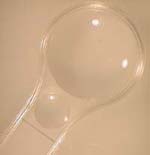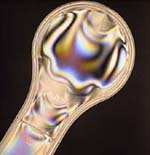Problems with Pyrex
Some interesting stories are starting to circulate about Pyrex cookware shattering violently under very modest handling.
A good article can be found at this
Consumer Affairs website:
Pyrex Panic: Shrapnel in the Kitchen
Nothing's worse than being betrayed by an old friend. So Molly of Wilkes-Barre, Pa., was shattered when her trusted Pyrex baking dish blew.
"I have used Pyrex and Corning Ware for all my 33 years of married life and never had a problem until last evening," Molly wrote us last October. "I had four people for dinner, had just taken a Pyrex baking dish from the oven and placed on top of stove when it exploded, sending glass all over."
Molly's dinner was ruined and there were burn marks on the carpet, where the shards of hot glass landed but, fortunately, no one was injured.
Not everyone is so lucky. Many of the consumers we've heard from, like Dave of Fort Smith, Ark., have become adept at picking shards of glass out of their feet and fingers. Dave was washing a Pyrex cooking dish in soapy water when he noticed something strange.
"My left hand index finger was starting to have a bad burning sensation. I continued on washing, not realizing that there was about an 3/4-inch-long piece of Pyrex glass stuck in my left index finger," Dave wrote, adding: "I mean stuck, stuck."
OK -- let's look at Pyrex for a moment.
What makes Pyrex different from regular glass are two major things:
#1) - Pyrex is another name for Borosilicate Glass and contains about 10% Boric Oxide in addition to the Silica and other chemicals.
From
Wikipedia:
The boron gives borosilicate glass a reduced thermal expansion coefficient (about one-third that of ordinary glass). This reduces material stresses caused by temperature gradients, thus making it more resistant to breaking.
#2) - Pyrex is also annealed which means that after it is molded to shape, it is held at near melting temperatures for a long time to allow the residual stresses to 'mellow out'.
From
Wikipedia:
Annealing, in glassblowing and lampworking, is heating a piece of glass until its temperature reaches a stress-relief point, that is, a temperature at which the glass is still too hard to deform, but is soft enough for internal stresses to ease. The piece is then allowed to heat-soak until its temperature is even throughout; the time necessary for this varies depending on the type of glass and thickness of the thickest section. The piece is then slowly cooled at a predetermined rate until its temperature is below a critical point, at which it can no longer generate internal stresses, and then the temperature can safely be dropped to room temperature. This relieves the internal stresses, making the glass much more durable. Glass which has not been annealed will crack or even shatter when subjected to a relatively small temperature change or other shock.
Emphasis mine -- for an excellent example of glass shattering with just a minimal effort, take a look at
this short video from the Tacoma Museum of Glass where they demonstrate a Physics classic, the Prince Rupert Drop. The bulb of the drop is so strong that you can actually hammer on it with surprising force but if you make the tiniest scratch on the tail, the whole thing shatters violently into small shards and powder.
The curious thing is that Corning no longer makes Pyrex cookware. They still retain the name but it is now made by
World Kitchen under license. Applying that famous razor of William of Occam (paraphrased as: "Given a choice between two explanations, choose the simplest -- the explanation which requires the fewest assumptions.") I am willing to guess that World Kitchen is not making Pyrex cookware, that their cookware has little or no Boron Oxide and that it probably has not been annealed.
There is a very simple test for revealing internal stress in transparent objects. Take two polarized lenses and rotate them 90 degrees to each other so the light passing through is reduced to the minimum amount. Put your object in between the two lenses and any stresses will show up as dramatic color bands and patterns of light and dark.
Edmund Optics has a page on polarization including these two pictures, one with and one without:


I am busy tomorrow but will try this in a few days. I have some old pieces of Pyrex cookware from about 15 years ago that have been through hell and back without a chip or crack. I'll pick up a new Pyrex pie plate and see if there is a difference...
Posted by DaveH at March 27, 2006 8:16 PM

